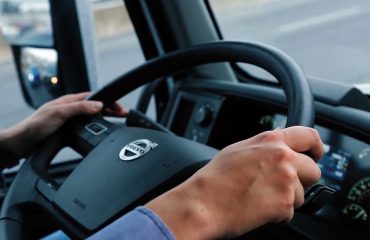In the fast-paced trucking industry, it’s easy to overlook drivers’ habits, which can have significant impacts. One such habit is idling – the practice of keeping a vehicle’s engine running while it’s not in motion. Although idling is a well-known issue, it warrants renewed focus due to its significant economic, health, and environmental impacts.
We wrote this article for transportation professionals who play a crucial role in implementing effective policies and practices, but it is also relevant for truck drivers who can directly influence idling behavior.
We will explore the importance of reducing idling, discuss the critical role of management in addressing the issue, examine effective strategies for reduction, and suggest incentive methods to encourage compliance. By understanding these aspects, management and drivers can make informed decisions that enhance fuel efficiency, reduce costs, and benefit the environment.
Why Reducing Idling is Important
Though often overlooked, the far-reaching effects of idling touch every aspect of fleet operations, from financial efficiency to driver health and environmental sustainability. The legal landscape increasingly demands compliance with anti-idling regulations, which can add economic and operational pressures. In Canada, provinces and municipalities have implemented stringent anti-idling regulations, with limits ranging from three to five minutes, and non-compliance can result in fines.
Economic Impact
The financial impact of idling can accumulate rapidly across a fleet of trucks. Consider the variation in idling habits between drivers in an average trucking company over a month. A driver who idles for 10 hours consumes approximately 30 litres of fuel, costing around $45. In contrast, a driver who idles for 100 hours in the same period could burn 300 litres of fuel, losing $450. When averaged across the entire fleet, idling might amount to roughly 55 hours per driver each month, consuming around 165 litres of fuel or about $250 per driver. For a company with 100 drivers, this could translate into an additional $25,000 per month spent on fuel due to idling alone. By reducing idling by half, the company could save $12,500 monthly and significantly reduce maintenance costs due to reduced engine wear and tear.
Health Impact
Idling also directly affects driver health. Prolonged exposure to exhaust emissions, which can accumulate in the cab during idling, has been linked to respiratory, cardiovascular, and other health concerns. Reducing idling not only contributes to a healthier work environment but also helps protect the well-being of drivers, potentially lowering healthcare costs and improving overall job satisfaction.
Environmental Impact
From an environmental perspective, reducing idling is crucial. Idling truck engines emit significant amounts of pollutants, including nitrogen oxides, carbon monoxide, and particulate matter, which degrade air quality and contribute to climate change. Additionally, idling is a significant source of carbon dioxide (CO2) emissions – a leading cause of global warming. By minimizing idling, the trucking industry can play a vital role in reducing greenhouse gas emissions and supporting broader efforts to combat climate change.
Management’s Role in Addressing Idling
Leadership Commitment
Leadership plays a pivotal role in addressing idling within a company. When senior management demonstrates a solid commitment to reducing idling, it sets a positive example and establishes it as a core value within the company’s culture. This commitment can drive organizational change, encouraging employees to adopt more sustainable practices and align their daily activities with the company’s environmental and economic goals. A culture that prioritizes efficiency and responsibility can lead to significant improvements in both operational performance and environmental impact.
Communication with Drivers
Effective communication with drivers is crucial for addressing idling issues. It’s essential to clearly articulate the significance of reducing idling and how it aligns with the company’s broader goals. Rather than focusing on punitive measures, management should foster a collaborative environment where drivers understand the benefits of reducing idling for their well-being and the company’s success. Open dialogue and supportive communication can encourage drivers to adopt best practices without feeling targeted or penalized.
Implementing Idling Policies
Incorporating idling reduction policies into the company’s operational framework is necessary. These policies should establish clear time limits for idling and include provisions for extreme weather conditions or specific operational needs. A comprehensive training program can educate drivers on reducing idling, emphasizing potential cost savings and health benefits. Managers should implement monitoring and reporting mechanism to track idling times and measure progress. Technology such as telematics systems and idle-reduction technologies can provide real-time data and automated solutions to support these policies and drive continuous improvement.
Strategies to Reduce Idling
Technology Solutions
Adopting advanced technology solutions can significantly reduce idling and enhance operational efficiency. Engine Block Heaters are an effective tool, especially in colder climates. They keep the engine warm when the vehicle is parked, reducing the need for idling to warm up the engine. Auxiliary Power Units (APUs) are another valuable investment. These units provide power for in-cab functions like heating and cooling without running the main engine, thereby saving fuel and minimizing wear on the engine.
Scheduling and Route Optimizations
Efficient scheduling and route planning are crucial to reducing idling times. By optimizing routes and schedules, companies can minimize waiting periods at loading docks and reduce unnecessary stops. Advanced logistics software can assist in planning the most efficient routes, taking into account traffic conditions and delivery times. Additionally, maintaining clear communication with dispatchers and clients helps ensure that drivers spend less time waiting and more time on the move, thus reducing overall idling.
Driver Education
Educating drivers on the importance of reducing idling is crucial for the successful implementation of idling reduction strategies. Driver Training and Awareness Programs should focus on the benefits of minimizing idling, including fuel savings, reduced engine wear, and improved air quality. Regularly providing drivers with practical tips and best practices for lowering idling can significantly improve fuel efficiency and operational performance. Engaging drivers in the process and highlighting the positive impact of their efforts fosters a culture of responsibility and efficiency within the company.
Incentive Methods to Encourage Compliance
Reward Programs
Implementing reward programs can effectively encourage drivers to comply with idling reduction strategies. Bonuses and recognitions are powerful incentives for good behavior. For example, offering financial bonuses to drivers who consistently meet or exceed idling reduction targets can motivate them to maintain low idling times. Recognizing drivers publicly through social media or company newsletters can boost morale and reinforce positive behavior. Conversely, it’s equally essential to constructively address instances of poor compliance, using them as opportunities for further training and improvement.
Gamification
Introducing gamification elements, such as contests or point systems, can make reducing idling more engaging. For instance, drivers could earn points or stars for reducing idling. These points can be accumulated and exchanged for rewards or prizes. Organizing periodic contests with attractive incentives, such as gift cards or extra time off, can motivate drivers to participate actively in the idling reduction program. Gamification makes the process fun and fosters a competitive spirit that drives performance.
Feedback System
Maintaining driver engagement through regular feedback is crucial for sustaining compliance. Establish a feedback system via the company’s newsletter or internal communication channels to inform drivers about their performance. Regular updates on idling statistics progress toward goals, and success stories can help drivers see the impact of their efforts. Providing constructive feedback and celebrating achievements helps keep drivers motivated and focused on reducing idling. A well-structured feedback system ensures that drivers feel valued and are continuously encouraged to improve their practices.
Measure Success and Continue Improvement
Data Analysis
To effectively measure the success of idling reduction initiatives, it’s essential to perform timely data analysis. Review metrics such as total idling hours, fuel savings, and maintenance costs regularly. Utilize telematics and tracking systems to gather accurate data and identify trends. Analyzing this data helps determine the effectiveness of current strategies and pinpoint improvement areas.
Adjusting Policies
Managers can adjust policies and procedures based on the insights gained from data analysis and feedback. They should regularly review and update idling reduction policies to reflect current performance and address emerging challenges. This could involve modifying time limits, refining training programs, or introducing new technologies. By staying responsive to data and feedback, companies can ensure that their policies remain effective and relevant.
Driver Involvement
Engaging drivers in the improvement process is crucial for sustained success. Actively solicit driver feedback to understand their perspectives and gather suggestions for enhancing idling reduction strategies. Giving drivers control and ownership over the process can boost their commitment and policy adherence. Encourage open communication channels where drivers can share their experiences and ideas. Involving drivers enhances the program’s effectiveness and fosters a collaborative approach to achieving the company’s goals.
Conclusion
Addressing engine idling offers substantial benefits, including reduced operational costs, improved driver health, and a positive impact on the environment while ensuring compliance with regulations. By implementing effective strategies and policies, transportation companies can achieve significant cost savings and contribute to a more sustainable industry. We encourage all trucking companies to evaluate their current idling practices, adopt technology solutions, optimize schedules, and engage drivers in reducing idling. These steps will drive efficiency, support environmental goals, and enhance operational performance.
Have questions or suggestions? Reach out to us at 416-907-8101
To learn more about Transam Carriers’ transportation services, please visit our page: https://www.transamcarriers.com/services
For career opportunities at Transam Carriers, visit our Careers page or email us: [email protected]




